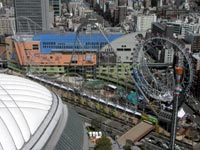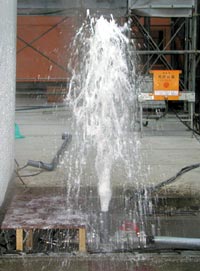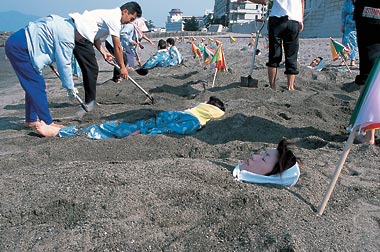 |
|
NIPPONIA No.26 September 15, 2003
|
|
Special Feature*
A New Hot Spring in the Middle
of the City
Spa LaQua, Tokyo Dome City, Tokyo
|
Spa LaQua opened on May 1, 2003, right in the middle of Tokyo. It has more water gushing out than any other hot spring in the metropolis. It is also a great place to relax and refresh yourself in modern, urban surroundings.
The spa is part of a recreation complex that includes the Tokyo Dome indoor stadium, an amusement park, and a tall hotel. The complex attracts about 30 million people every year.
Spa LaQua has plenty to offer — outdoor hot pools designed like rustic springs in the mountains, saunas shaped like mountain huts, a zone laid out like a Southeast Asian resort, and more — all in the heart of the city. The designers have created the illusion of another world.
It is said that if you drill 1,000 meters straight down under Tokyo, you will probably strike a hot spring. Spa wells have been drilled in different parts of the metropolis, such as at Odaiba, on land reclaimed from Tokyo Bay. But at Spa LaQua they went deeper — 1,700 meters down — in order to reach a better quality spring. The water gushing up is said to be seawater trapped underground during a glacial period more than 30,000 years ago.
 |
|


Top: Spa LaQua is part of a complex that includes an indoor baseball stadium and an amusement park.
Above: This spring shoots up from the ground under the metropolis of Tokyo.
Left: Outdoor hot pool for men. Well-equipped saunas and jacuzzis are located nearby. The facilities are closed only between 9 and 11 a.m.
|
|
Getting there:
About 10 minutes on the Eidan Marunouchi subway line from Tokyo Station to Korakuen Station. If arriving directly from overseas, first take the Narita Express train from Narita Airport to JR Tokyo Station (about 1 hour).
|
Hot, Heavy Sand Takes Away That Tired Feeling
Natural Steaming Sand Bath, Ibusuki, Kagoshima Prefecture
|
Hot springs gurgle up in many places near the shore at Ibusuki, Kagoshima Prefecture. You can soak in them, of course, but Ibusuki is best known for its steaming sand baths. For more than 300 years, the Japanese have been coming here to be buried up to the neck in sand. The heat energy comes from underground.
The sand is about 55°C (130°F), too hot to endure if it were water, but no problem here, since the air spaces between the grains of sand moderate the heat.
Pits are dug in the beach, about 10.cm deep and the length of a human body. You lie in one, face up, and the attendant covers every part of you with sand, except for your head. When you first stretch out in the pit the sand is hot on the back, and when sand is placed on you it weighs you down and adds even more heat to your entire body. The blood seems to surge through your veins from head to toe — obviously this "sand bath" is making your heart circulate the blood well!
Although the sand is hot at first, soon a good feeling spreads all over. Ten minutes lying there is about right. When you stand up and brush off the sand, you will find yourself covered in sweat — but you will feel great, like a weight has been lifted off of you.  |
 |
|
A steaming sand bath is said to offer therapeutic relief from neuralgia, rheumatism, back pain and other ailments. The sand bath and a soak in a hot pool cost 900 yen.
|
|
Getting there:
About 1 hour by air from Kansai International Airport to Kagoshima Airport, then 90 minutes by bus to Ibusuki.
|
|
 |